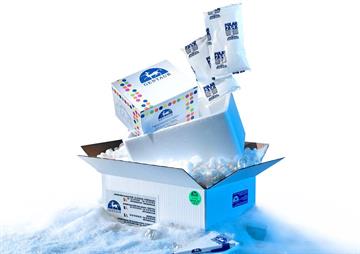PDE4D TR-FRET Assay Kit

PDE4D TR-FRET Assay Kit
0.01 EURAsk for quotation
On request
quantity
Produktdetaljer
Katalognummer: 137 - GWB-PS9965
Produktkategori: Företag och industri > Vetenskap och laboratorium
GenWay BiotechGentaur
Storlek: 96reactions
Related Products
60701
PDE4D3 TR-FRET Assay Kit
The PDE4D TR-FRET Assay Kit is designed for identification of inhibitors of PDE4D using TR-FRET (Time Resoled Fluorescence Resonance Energy Transfer) technology. Using this kit, only two simple steps on a microtiter plate are required for the PDE4D activity assay. First, the fluorescent-labeled cAMP is incubated with a sample containing PDE4D3 for 1 hour. Second, a binding agent and a terbium donor are added to the reaction mix and incubated for 1 hour. Then, fluorescence intensity can be measured using a fluorescence reader.
757.5 €
60707
PDE4D2 TR-FRET Assay Kit
The PDE4D2 TR-FRET Assay Kit is designed for identification of inhibitors of PDE4D2 using TR-FRET (Time Resolved Fluorescence Resonance Energy Transfer) technology. Using this kit, only two simple steps on a microtiter plate are required for the PDE4D2 activity assay. First, the fluorescent-labeled cAMP is incubated with a sample containing PDE4D2 for 1 hour. Second, a binding agent and a terbium donor are added to the reaction mix and incubated for 1 hour. Then, fluorescence intensity can be measured using a fluorescence reader.
757.5 €
78131
FXR Agonist Assay Kit (TR-FRET)
The FXR (Farnesoid X Receptor) Agonist Assay Kit (TR-FRET) is designed to measure binding of the FXR and SRC-1 (Steroid Receptor Coactivator 1) for screening FXR agonists using TR-FRET technology. With this homogeneous kit, the FXR agonist assay can be performed by adding all materials, including the detection reagents, to the wells and incubating the plate for 2-hours at room temperature followed by reading the TR-FRET signal._x000D_
1222.5 €
78301
Cereblon intrachain TR-FRET Assay Kit
Covalent conjugation to ubiquitin (Ub) is one of the major post-translational modifications that regulates protein stability, function, and localization. Ubiquitination is the concerted action of three enzymes: a Ub-activating enzyme (E1), a Ub-conjugating enzyme (E2), and a Ub ligase (E3). The specificity and efficiency of ubiquitination are largely determined by the E3 enzyme, which directs the last step of the Ub-conjugating cascade by binding to both an E2~Ub conjugate and a substrate protein. This step ensures the transfer of Ub from E2~Ub to the substrate, leading to its mono- or poly-ubiquitination.The Cereblon (CRBN) protein via its interaction with the DNA damage-binding protein-1 (DDB1), Cullin 4 (Cul4A or Cul4B), and regulator of Cullins 1 (RoC1) forms the functional E3 Ub ligase complex. In this complex, Cereblon functions as a substrate receptor that mediates the ubiquitination and subsequent proteasomal degradation of target proteins. Cereblon complex is involved in many biological processes including cell proliferation and apoptosis. That is why it has been employed for targeted protein degradation in the treatment of cancer. Like most E3 ligases, Cereblon complex ubiquitinates itself and this auto-ubiquitination promotes its Ub ligase activity.The Cereblon intrachain TR-FRET Assay Kit is a sensitive high-throughput screening (HTS) TR-FRET Assay Kit, designed to measure Cereblon auto-ubiquitination activity in a homogeneous 384 reaction format. It utilizes a Europium cryptate-labeled Ub (donor) as well as Cy5-labeled Ub (acceptor) to complete the TR-FRET pairing. Since both the TR-FRET donor and acceptor are incorporated into poly-ubiquitin chains formed on Cereblon, this FRET-based assay requires no time-consuming washing steps, making it especially suitable for HTS applications as well as real-time kinetics analyses of polyubiquitination.
2775 €
78302
MDM2 intrachain TR-FRET Assay Kit
Covalent conjugation to ubiquitin (Ub) is one of the major post-translational modifications that regulates protein stability, function, and localization. Ubiquitination is the concerted action of three enzymes: a Ub-activating enzyme (E1), a Ub-conjugating enzyme (E2), and a Ub ligase (E3). The specificity and efficiency of ubiquitination are largely determined by the E3 enzyme, which directs the last step of the Ub-conjugating cascade by binding to both an E2~Ub conjugate and a substrate protein. This step ensures the transfer of Ub from E2~Ub to the substrate, leading to its mono- or poly-ubiquitination.The human Mouse double minute 2 homolog (MDM2) is an E3 Ub ligase and the master regulator of tumor suppressor proteins such as p53. Thus, high activity of MDM2 can promote tumor formation by targeting tumor suppressor proteins for proteasomal degradation, enabling cancer cell survival and proliferation. That is why MDM2 is an attractive potential drug target in cancer immunotherapy. Like most E3 ligases, MDM2 ubiquitinates itself and this auto-ubiquitination stimulates MDM2 Ub ligase activity.The MDM2 intrachain TR-FRET Assay Kit is a sensitive high-throughput screening (HTS) TR-FRET Assay Kit, designed to measure MDM2 auto-ubiquitination activity in a homogeneous 384 reaction format. It utilizes a Europium cryptate-labeled Ub (donor) as well as Cy5-labeled Ub (acceptor) to complete the TR-FRET pairing. Since both the TR-FRET donor and acceptor are incorporated into poly-ubiquitin chains formed on MDM2, this FRET-based assay requires no time-consuming washing steps, making it especially suitable for HTS applications as well as real-time kinetics analyses of polyubiquitination.
2325 €
Håll dig uppdaterad! Visa tidigare publikationer

By: Author , 2 Comment
Anaplasmos hos hundar och katter – allt du behöver veta
23 August 2025

By: Author , 2 Comment
Solbränna – hur leker man säkert i solen?
16 August 2025

By: Author , 2 Comment
Biologiska läkemedel – Modernitet inom farmaci
1 August 2025

By: Author , 2 Comment
Icke-steroida antiinflammatoriska läkemedel – viktig information om populära läkemedel
22 July 2025








